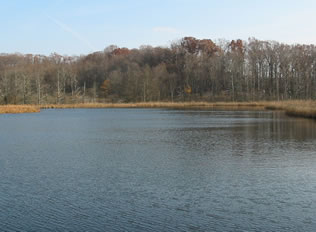|

Lakes
Indiana's landscape is covered
with over 160,000 acres of lakes and reservoirs, plus another
154,000 acres of open water on Lake Michigan.
The two areas in the state with the most lakes are northeast
and northwest Indiana.
The major inland lakes and reservoirs in Indiana include Lake
Wawasee, Monroe Lake, Morse Reservoir, Geist Reservoir, Brookville
Lake, and Patoka Lake.
Lakes are "large natural
bodies of standing freshwater formed when precipitation, runoff,
or groundwater seepage fills depressions in the earth's surface"
(Miller 163). All three types of lakes exist in Indiana: oligotrophic,
which is a poorly nourished, deep, crystal blue or green lake;
eutrophic, which is a well-nourished, shallow, murky brown
or green body of water; and mesotrophic, which is a lake that
features both oligotrophic and eutrophic characteristics.
Another body of water abundant
in Indiana and closely related to lakes is ponds. However,
ponds usually have vegetation cover across the entire bottom,
whereas many lakes are too deep to have such extensive coverage,
especially across the bottom of the middle of the lake where
sunlight may reach only moderately. Another difference is
that ponds do not have any strata, or layers, of variable
temperatures. Lakes, to be classified as such, must have at
least two strata.
Lakes support a wide range of
other ecosystems, such as wetlands,
like bogs and fens, and forests.
An excellent example of the diverse range of ecosystems that
surround a lake is Lake Michigan, which is located at the
northwestern
tip of the state. Sand dunes,
wetlands, forests,
and prairie are all a part of this
environmentally rich area.
Lake Michigan is part of the
largest reservoir of fresh water in the world. As a former
employee of the Indiana Department of Natural Resources notes,
"No one can look across its vast expanse without feeling
a sense of awe for this natural wonder" (Hedge 216).
However, in this particular case, as is the case for many
of Indiana's bodies of water, water
quality is an important issue. For example,
Lake Michigan's waters have been a victim of urban
sprawl, industrial
runoff, and, more recently, the invasion of non-native
species—most notably, the zebra mussel.
As the example
of Lake Michigan demonstrates, the consequences of water
pollution are vast and sometimes irreversible. Thus,
it is important to keep Indiana's lakes clean as they are
not only home to aquatic life, like fish and plants, but also
provide surrounding habitats for animals native to the shoreline,
wetlands, and forests.
Sources:
Hedge, Michelle Martin. "The
Southern Tip of the Big-Sea Waters: The Lake Michigan Natural
Region." The Natural Heritage of Indiana. Ed.
Marion T. Jackson. Bloomington: Indiana UP, 1997. 214-16.
Miller, G. Tyler, Jr. Environmental
Science: Working with the Earth. 8th ed. Pacific Grove,
CA: Brooks/Cole, 2001.
State of Indiana. Department of Environmental
Management. Office of Water Quality. "Executive Summary."
Indiana Integrated Water Quality Monitoring and Assessment
Report 2002. 2002. 18 Nov. 2002
<http://www.in.gov/idem/water/planbr/wqs/quality/
2002integrept/execsumm.pdf>.
|




